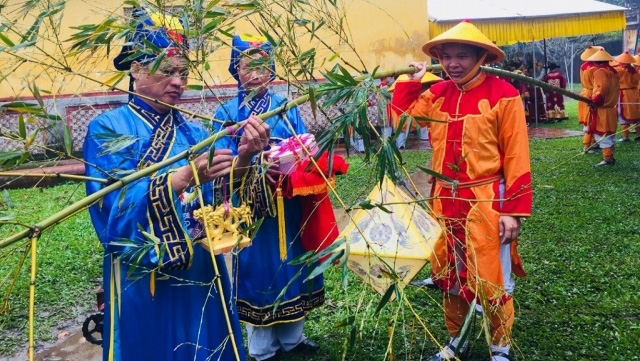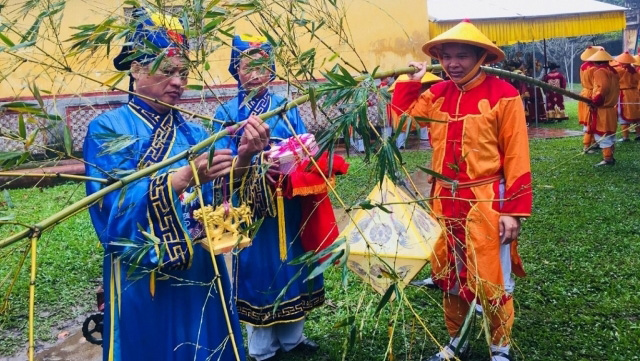
A Neu pole, a tall bamboo tree with red garment strips used to dispel evil spirits during Tet (Lunar New Year) festival, was erected at Hue Imperial Citadel in Thua Thien-Hue province on January 28.
|

Neu pole installed at Hue Imperial Citadel to welcome Lunar New Year
(Photo: tintucvietnam.vn)
|
|
|
|
The installation
of the tree is a traditional ritual practice of the Vietnamese people to mark
the beginning of Tet.
The
15-metre long bamboo pole was carried out by a group of 10 men who were
dressed in the uniform of soldiers under the Nguyen Dynasty.
They were
accompanied by a guard of honour and a band of royal court music to join a
procession from Hien Nhon gate through Thai Hoa Palace to arrive at the
Ancestral Temple, where emperors of the Nguyen dynasty are worshipped.
Two other
Neu pole were also installed at Trieu Mieu and Long An temples at the
Imperial Citadel at the same time.
Also on the
occasion, the Hue Relics Preservation Centre hosted a programme offering
visitors a string of activities, including royal games, calligraphy and
martial arts performances, traditional dragon and lion dances, and a chung
(square) cake making contest.
|
Source: NDO
With an increasingly vibrant and widespread emulation movement aimed at building cultured residential areas and cultured families, Yen Thuy District has been making steady progress toward improving both the material and spiritual well-being of its people, while fostering a civilized, prosperous, beautiful, and progressive community.
Once lacking recreational spaces and community facilities, Residential Group 2 in Quynh Lam Ward (Hoa Binh City) has recently received attention for the construction of a new, spacious, and fully equipped cultural house. The project followed the model of state support combined with public contributions in both labor and funding.
The "All people unite to build cultural life" movement, which has been effectively integrated with Kim Boi district’s socio-economic development goals, is fostering a lively spirit of emulation across local residential areas, hamlets, villages, public agencies, and enterprises. In addition, through the initiative, traditional cultural values are being preserved and promoted, while community solidarity and mutual support in poverty reduction and economic development are being strengthened.
A working delegation of the Hoa Binh provincial People’s Committee led by its Permanent Vice Chairman Nguyen Van Toan on June 11 inspected the progress of a project to build the Mo Muong Cultural Heritage Conservation Space linked to tourism services in Hop Phong commune, Cao Phong district.
Born and growing in the heroic land of Muong Dong, Dinh Thi Kieu Dung, a resident in Bo town of Kim Boi district, in her childhood was nurtured by the sweet lullabies of her grandmother and mother. These melodies deeply imprinted on her soul, becoming an inseparable part of her love for her ethnic group's culture. For over 20 years, this love for her hometown has driven Dung to research, collect, and pass down the cultural values of the Muong people to future generations.
In the final days of May, the Ethnic Art Troupe of Hoa Binh Province organized performances to serve the people in remote, mountainous, and particularly disadvantaged areas within the province. These were not just ordinary artistic shows, but they were the meaningful journeys aimed at spreading cultural values, enhancing the spiritual life of the people and contributing to the preservation of ethnic minority cultural identities.


